×
×
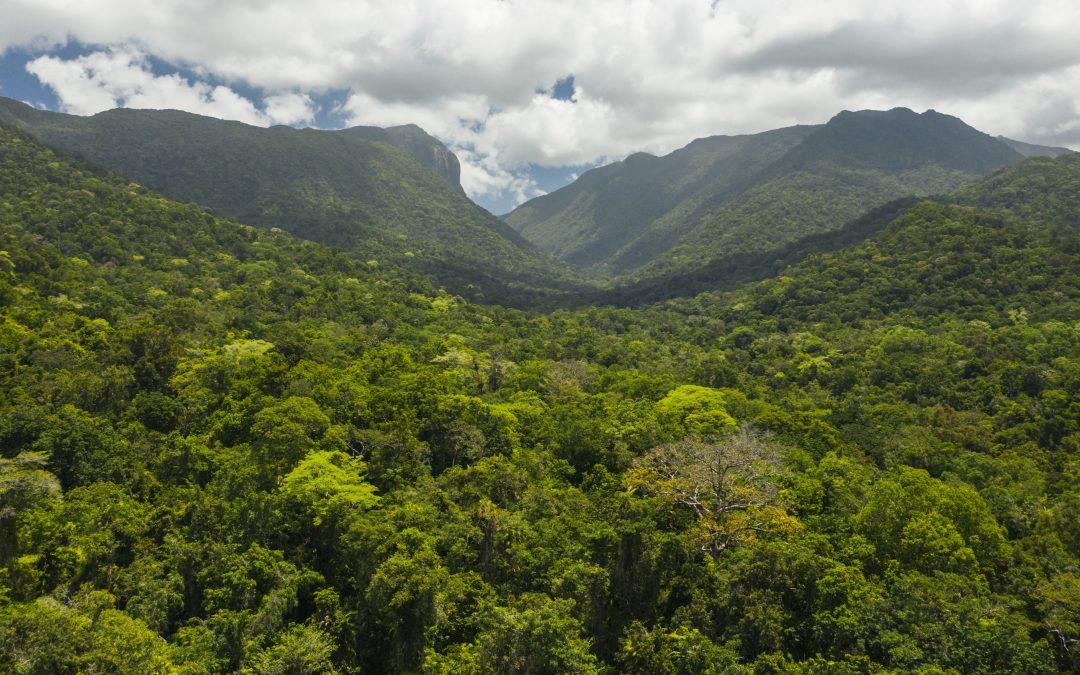
The spectacular Daintree Rainforest region begins at the Mossman Gorge, in the World Heritage listed Daintree National Park. Only an hour’s drive north of Cairns, the region reaches north through farmlands, valleys and mountains, then across the Daintree River to the ancient rainforests of Cape Tribulation. It is here, one of the few places in the world, where two World Heritage listed areas meet – the Daintree Rainforest and the Great Barrier Reef.
The Daintree Rainforest is exceptional in many ways. It is one of the oldest continuous living tropical rainforests in the world – around 140 million years old, give or take a millennia. It contains one of the most complete and diverse living records of the major stages in the evolution of land plants, particularly in the origin, evolution and dispersal of flowering plants. It also provides a glimpse in the history of local fauna, it’s vastness containing some species older than human life itself.
CULTURAL HISTORY
The Kuku Yalanji people are the Indigenous inhabitants of the land and have a history dating back 50,000 years to the earliest human occupation of Australia. They are true rainforest bama (people), living in complete harmony with their environment. It is part of them, and they are part of it, a notion that is movingly brought to life during an Indigenous guided walking tour of Mossman Gorge. Their traditional country extends from south of Mossman to Cooktown in the north, and Palmer River in the west.
An integral part of the belief system of the Kuku Yalanji, also known as ‘rainforest people’, revolves around nature and the knowledge of its intimate cycles. This information has remained alive and well within the Kuku Yalanji, with present custodians passing on the knowledge of their forefathers, which their forefathers passed on before them (and so on).
Eastern Kuku Yalanji identiy is based on Ngujakura (Dreaming) and is reflected in their living connection to bubu (land) and jalan (sea) and their continued aspiration to conserve and protect country. Waterways are a significant part of Eastern Kuku Yalanji culture as the yirrmbal (rainbow serpent) travels along them. Yirrmbal forms lore and imparts knowledge and decision-making responsibilities which are the basis of traditional management. The estuaries, mangroves, mudflats are breeding grounds for crustaceans and molluscs. The beaches are used by ngawiya (turtles) to lay eggs and the fringing reefs support many varieties of kuyu (fish) and kirrbaji (dugong). Easter Kuku Yalanji is home to many threatened species including beach stone curlews and kurranji (cassowary)
Yalanji clan groups provide advice on the management of World Heritage areas in the Great Barrier Reef and Daintree Rainforest. The Indigenous Protected Areas contain many cultural sites; story places, burial and birthing sites. For this reason, elders request that visitors stay on approved walking tracks, swim in approved places, and do not remove plants, stones or resources, and refrain as much as possible from taking and sharing photographs of these cultural sites.
WORLD HERITAGE STATUS
If you’ve ever wanted to see a real-life Jurassic World, you’ll find some degree of comfort in the Daintree Rainforest – the land time forgot. The region referred to as ‘The Daintree Rainforest’ covers an area of approximately 1,200 square kilometres, or roughly 220,000 football fields. This spectacular region is remarkable for many reasons, but primarily because it’s the oldest continually living, tropical rainforest in the world, boasting an ancient ecosystem with more biodiversity than even the Amazon.
The Daintree region attained World Heritage listing in 1988, following a federal government campaign to push back against logging and agricultural clearing endorsed by the then state government. UNESCO recognised it as an ‘extremely important’ site of rich and unique biodiversity, containing relics of the great Gondwanan forests that covered Australia and parts of Antarctica before the continents split up 50 to 100 million years ago. With over 3,000 plant species, 107 mammals, 368 bird and 113 reptile species, and an actively living and operating indigenous population – now identified as the oldest living culture in the world – this area presents an unparalleled record of the ecological and evolutionary processes that shaped the flora and fauna of Australia.
THE DAINTREE DISCOVERY CENTRE
Before Daintree Discovery Centre was built, there was nowhere for visitors to the region to actually experience the rainforest firsthand, explore the fauna and flora, or begin to understand the historical, biological and social context of this unique wilderness. Unfortunately, those who were venturing into the rainforest through commercially motivated, man-made walking trails were creating unimaginable harm to such ancient areas including Noah Creek and Thornton’s Beach, damaging the fragile vegetation and disturbing the wildlife.
The urgent need for interpretive information – and more particularly for an environmental centre that would allow controlled access to the rainforest, while at the same time protecting the fragility of the environment. So, in 1988, the development of an educational interpretive centre in the Daintree Rainforest began. And it was no mean feat – with no power, no telephone and limited local labour, the odds of success were certainly stacked against the project.
Alongside extensive consultation with the National Parks and Wildlife Service, the local Council, the CSIRO, and various educational and rainforest research centres, the Daintree Discovery Centre was finally completed, and is now an award-winning must-see where visitors can experience the rainforest at every level.
Entry sees visitors equipped with a cornucopia of information, from the comprehensive guidebook to a state-of-the-art audio guide that talks you through the bush-food trail, the cassowary circuit, and the quite realistic Jurassic Forest track, complete with animatronic dinosaurs.
A 125-metre metal aerial walkway keeps things easy, and the climb to the 23-metre-high observation tower tests aerobic fitness, but the views are more than worth the rapid heartbeat. Keep an eye out for cassowaries along the ground-level rainforest boardwalks, often seen exploring the area!
The interpretive Display Centre offers an epic history of evolution starting with the Big Bang Theory moving all the way through the formation of Gondwana, and several interactive information kiosks with touch screen displays to allow easy access to a variety of information suitable for all ages.
The Daintree Rainforest is possibly one of Nature’s greatest playgrounds – make the Daintree Discovery Centre part of your rainforest discovery itinerary when visiting!

Often we see a gigantic female wandering along the creek in search of fallen fruit, and our ‘resident’ male with a clutch of chicks in tow.
During April to June, in the Daintree Rainforest, most male cassowaries evict their young and the juveniles start fending for themselves. Cassowaries are territorial and the juveniles’ survival depends on establishing a ‘home range’ of their own. This is a gradual process of acquisition by increments. Most juveniles are familiar with the parent’s routine and you will often spot a newly evicted bird shadowing an adult or sneaking into a popular feeding ground just before the parent arrives.
As the courting period nears, the adults become intolerant of juveniles so keeping out of their parents’ way is a strategy adopted to avoid unnecessary conflict.
It can be difficult to tell the sex of a cassowary as their colouration is identical. Courtship is one of the few times the difference is obvious – the females being markedly larger than the males. Otherwise, it’s when you see an adult with young – the males incubate the eggs and raise the young.
It is generally accepted the father will raise the young for 6-9 months, but it can be longer. At the Discovery Centre we observed the ‘resident’ male looking after his three chicks for nearly 15 months. We could often see them from the Coffee Shop deck.
When very young, the chicks would constantly whistle to stay in close contact, and panic if they lost sight of the group. As they matured you could see them become more adventurous; no longer hurrying to catch up with Dad each time he moved away, but pausing to drink from the creek or to take a quick dip.
I remember when a chick became separated from the group, the distressed father kept calling out and marching back and forth until the wayward chick stumbled over the rise, to be safely reunited with Dad and siblings.
It amazes me that the male cassowary can suddenly change from this careful, caring parent to become cantankerous once the breeding season approaches. You can imagine how very proud we were when our ‘resident Dad’ skipped one whole breeding cycle in order to care for his chicks into their second year.
Although it is not unknown for chicks to stay with their father up to 20 months, it is unusual. There are often practical explanations – the fruiting season may have been poor and the chicks’ development was slower than normal; the adult male may have been inexperienced; or he may not have found a suitable breeding female.
There is so much that is not understood about these magnificent birds and I am continually reminding people that there is a whole world of information out there waiting to be gathered. Despite a wealth of scientific data, the Daintree Rainforest still holds most of its ancient secrets.
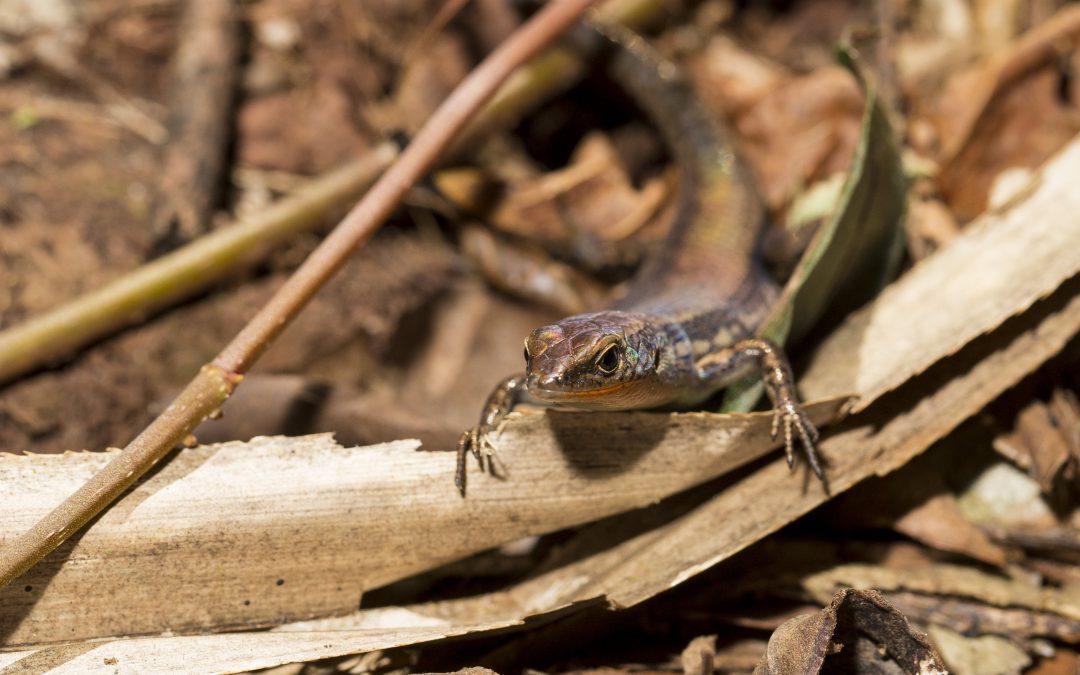
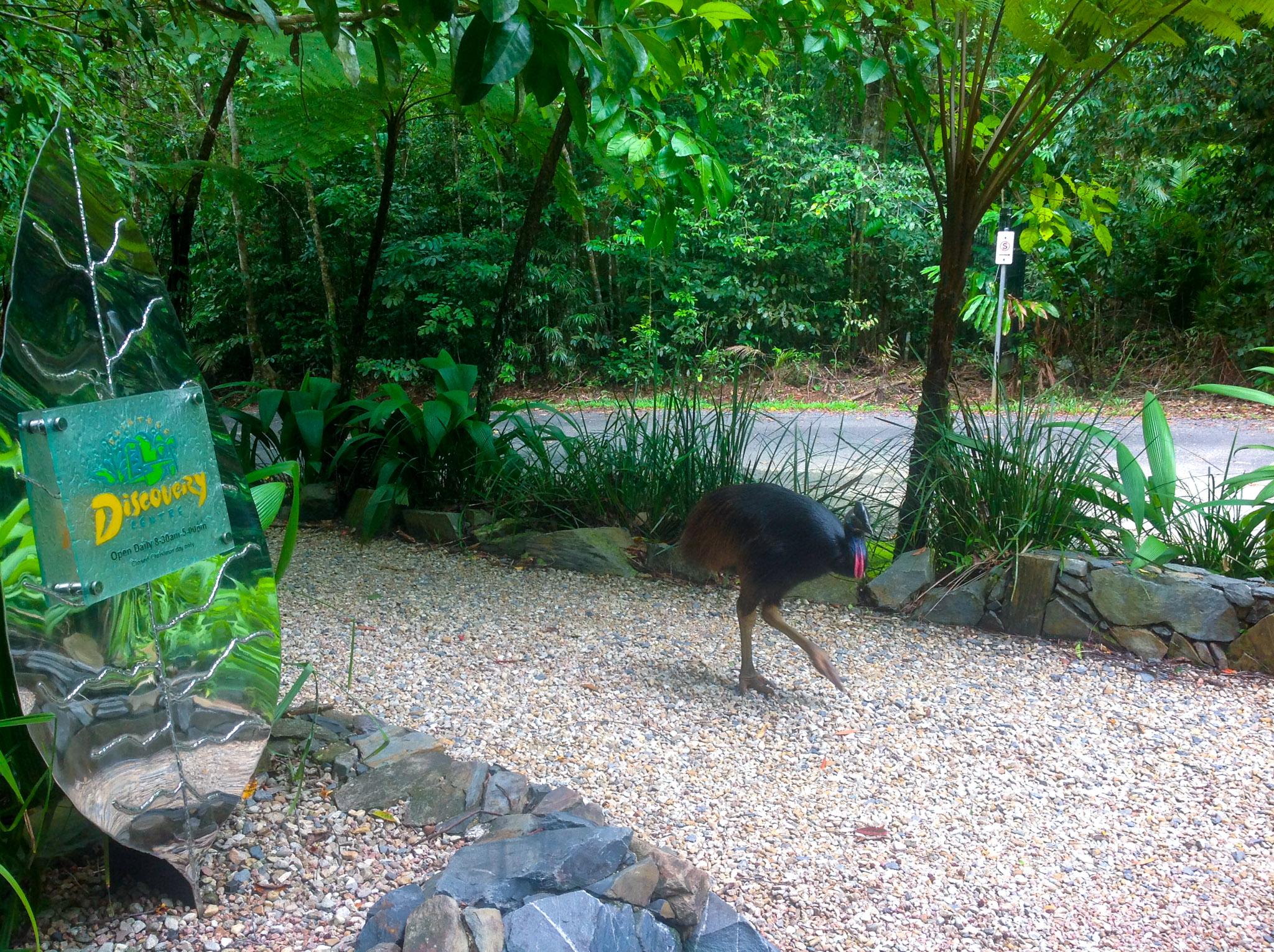
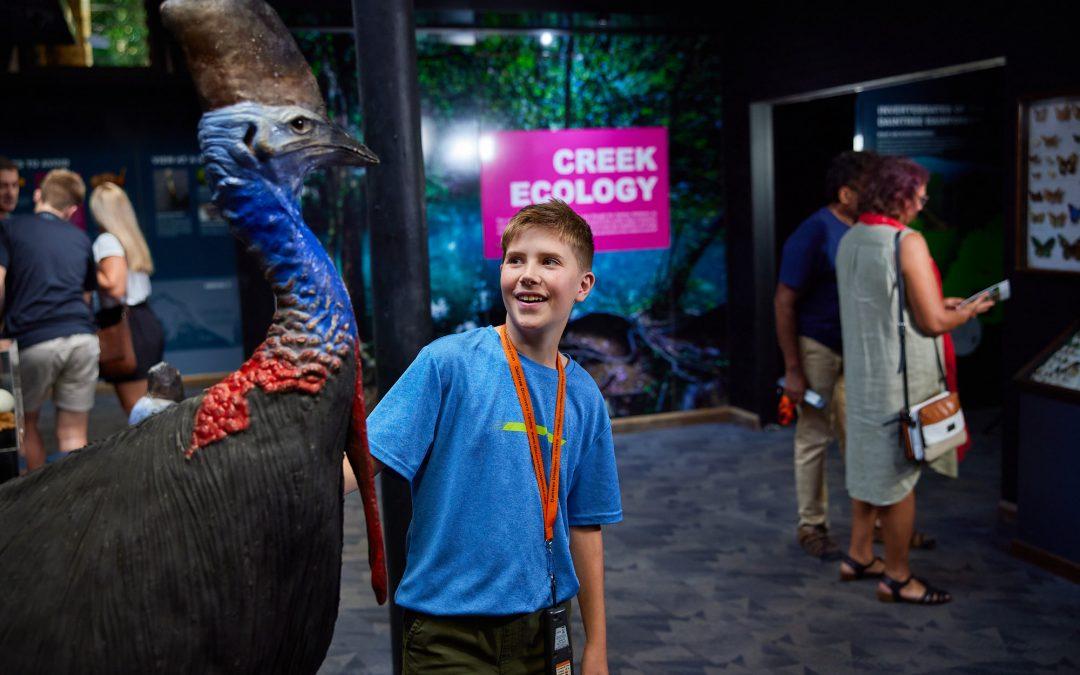
Located 10 kilometres north of the river in the heart of Cape Tribulation, the Daintree Discovery Centre is the must-do spot for the eco-conscious traveller, for kids wanting to know what life was like when dinosaurs roamed (and even spot a few!), and for anyone interested in the general magnificence of the oldest continually living rainforest on the planet.
The Daintree Discovery Centre is the fully immersive and interpretive centre where visitors can experience the rainforest at every level – from high above the canopy looking down at spectacular flora, walkways through the mid-level heart of the rainforest, through to the forest floor, keeping an eye out for cassowaries. Self-guided audio tours are also available, and feature interesting information of how the traditional local Aboriginal people made good use of the natural features of the rainforest.
But with all these exciting activities, it can be a little overwhelming to decide what to do, making sure nothing is left out! We’ve put together a handy checklist for you to make sure no rainforest experience is left unexplored.
1. Immerse Yourself in The Land Time Forgot
Explore the ancient rainforest at every level! Starting at ground level, discover the magic of the rainforest floor, the place where life strains and struggles for light, yet still remains so lush. This vibrant and natural part of the forest has over 400 metres of elevated boardwalks to provide the best viewing for the least amount of impact, allowing visitors to take their own pace through the wilderness. There’re also strategically placed bench seats where you can rest for a while, taking in the magnificence of this natural beauty that surrounds.
Often much richer in life than the forest floor, the canopy can be hard to see at eye level, which is what makes the Aerial Walkway so special. At 11m high and 125m in length, this elevated walkway through the trees allows an unparalleled view into the mid-level rainforest as well as impressive views over McLean’s Creek.
2. Walk On Top of A Rainforest Canopy
Standing 23 meters tall in the middle of thick tropical rainforest, The Canopy Tower provides a truly unique and intimate way to experience the rainforest at different levels, from the forest floor all the way up to the top of the canopy. With information on each of the five levels you’re sure to learn a thing or two (and get your aerobic fitness up) as you ascend through the rainforest levels.
3. Put Yourself in Jurassic World
120 million years ago (give or take a millennia), dinosaurs roamed the super continent Gondwana. While a few things have changed since then (like wifi and Netflix), what hasn’t changed much is the ancient rainforest where we stand today. Take a walk along the Jurassic Forest Track, a path full of life-sized animatronic dinosaurs, guaranteed to surprise and delight everyone.
A seven-metre-long Ripper Lizard, a Giant Thunderbird and a dynamic Diprotodon are among the extraordinary creatures that can be spotted at the Discovery Centre. Four of the seven models are believed to be remnants of a special group of dinosaurs that lived in various parts of Queensland around the Jurassic Period. *RAWR*.
4. Go Dinosaur Spotting… (for real!)
They still exist, you know! Well, their direct descendants do… Cassowaries are believed to be real life relatives of the terrifying velociraptors, a sickle-clawed dino-bird that flourished in central and eastern Asia and Australia about 100 million years ago. They started to evolve, and as of about 40 million years ago the cassowary as we know it remained stable.
Vital to the survival of the rainforest, the Southern Cassowary eats fallen fruit and distributes seeds across the rainforest floor via their droppings. Many trees rely on this methos of seed dispersal to reproduce. By following the Cassowary Circuit, you’ll learn more about the animal, what they eat, and how the species has survived for so many years (and maybe spot one or two!).
5. Learn About Bush Tucker
Australian bush foods have been on the menu for our Indigenous people for over 40,000 years. If you’re keen to better understand bush tucker, you’re in luck – on this immersive walking tour, you’ll discover ancient stories of the Daintree’s Kuku Yalanji people as you make your way through the rainforest, signage pointing out traditional tucker as you go. On the Bush Tucker Trail you’ll learn more about native rainforest nuts, spices and fruits, as well as the plants of the rainforest and how these plants can be used for medicinal purposes.
6. Take A Moment Under an Ancient Fig Tree
Looking up at the giant strangler fig tree at the Daintree Discovery Centre can make a person feel rather insignificant, awed in the magnificent enormity of its stature. Thought to be between 500-600 years old, this strangler fig is amongst the world’s most spectacular and curious plants.
Each ‘tentacle’ starts off as a tiny fig seed that germinates high up in the canopy of a tree. It sends down an intricate web of roots, which gradually wind round the trunk of the host tree. Strangler figs are epiphytes – plants that survive without roots in the ground and trap all the nutrients and moisture they need as it falls from the forest above. They are not parasitic, but they do eventually kill the host tree.
7. Go Tech While Off Grid
This incredible educational facility definitely puts the fun in learning! Informative audio guides in 8 languages, rainforest reptiles and native fish displays, children’s audio guides and displays, a mini theatre, an interpretive centre with touch screens, all providing a huge wealth of information about the rainforest ecosystem presented in fun, interactive ways. centre offers several touch screen with easy access to a variety of information suitable for all ages, as well as colourful displays incorporating lots of images and easy-to-read text.
Learn in remarkable detail about the many animal species – big and small – that call the rainforest home, from the famous cassowary and crocodile to the humble green tree frog. There’s also a 3D cassowary display with life size models, and a reptile room where you can get all up close and personal with the slithery rainforest folk.
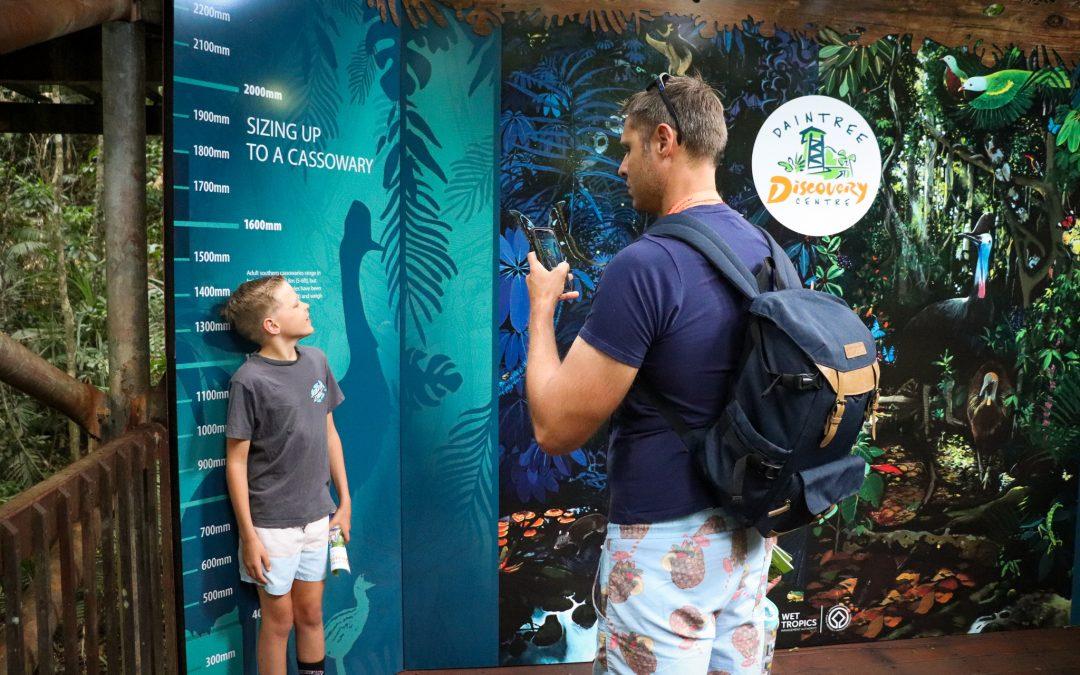
They eat fruit from at least 26 different plant families, most of which are highly poisonous to humans. Rainforest fruits such as Black Palms, Finger Cherries, Davidson Plums, Cluster Figs, Silver Quandongs and Noah’s Walnuts are particular favourites.
The Southern Cassowary is a keystone species because they eat fallen fruit whole and distribute seeds across the rainforest floor via their droppings. Many trees rely on this method of seed dispersal to be able to reproduce. Once the fruit has passed through the bird, most of the fleshy part has been removed from the seed leaving it ready to germinate from a lovely pile of compost – or Cassowary Poo! – to you!
Have you sized up to our cassowary at the Discovery Centre?
Cassowaries are large birds, and will grow as tall as 1.80m, with the females being bigger and stronger than the males – they can even reach up to 2 metres and may weigh up to 60 kilograms. Come visit and compare your height to theirs!

The Daintree Discovery Centre elevated tree top walks offers a unique rainforest experience. The 11-metre-high aerial walkway provides unrivalled views of the Daintree’s ancient flora and fauna, from the rainforest floor up into the soaring heights of the treetops.
Climb to the top of the 23-metre high Canopy Tower, stopping at each of the five viewing platform for unparalleled access to the individual layers of the rainforest canopy. Descend to the rainforest floor and enjoy the serenity along the Cassowary Circuit, taking in the ancient king ferns at the McLean’s Creek lookout.